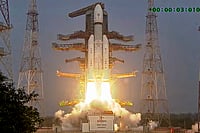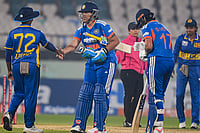Ahead of World Diabetes Day on November 14, health experts have voiced alarm over the growing prevalence of the chronic condition among India’s young population and women, noting that the disease is no longer confined to older adults.
India has a high prevalence of diabetes, with over 101 million people affected and 136 million pre-diabetic, making it a significant public health issue.
The rise, said the doctors, is being fuelled by sedentary lifestyles, air pollution, post-COVID health complications, and poor dietary habits such as consumption of junk/processed food.
“Nearly 90% of diabetes cases are linked to lifestyle factors,” said Dr. Rajeev Gupta, Senior Director and Head of Internal Medicine, Yatharth Hospital, Model Town, Delhi at a press conference in the national capital.
“Prolonged screen exposure, physical inactivity, and unhealthy diets impair insulin efficiency. Even children spending over three to four hours daily on screens are exhibiting early signs of insulin resistance.”
Dr. Gupta added that around 40% of the hospital’s out-patient cases are diabetes-related, with most patients aged between 40 and 60 years. “There is also a worrying rise among young adults (5–7%) and children (1%),” he noted.
Dr Rajeev Gupta also urged the Government to ban indoor sitting games and minimise screen time so that they do not fall in the diabetes trap.
Dr. Sanjay Gupta, Senior Director, Internal Medicine, Yatharth Hospital, concurred with his colleague observing that Type-2 diabetes is increasingly being detected in individuals below 25 years. Citing a recent study, he said the prevalence among adolescent boys stands at 12.3% and among girls at 8.4%. “Many Indians, though lean, have high visceral fat, predisposing them to diabetes and related complications,” he said, calling for regular health screenings as the disease often progresses silently.
Air pollution has also emerged as a major contributor, said Dr. Anil Gomber, Senior Consultant, Internal Medicine and Diabetologist. “Long-term exposure to PM2.5 raises diabetes risk by nearly 22%. Even short-term exposure can elevate fasting glucose levels. Pollution-induced inflammation and oxidative stress interfere with insulin function,” he explained.
He added that gestational diabetes affects nearly 15–16% of women, increasing risks of miscarriage, hypertension, and C-sections. “Children born in such cases are more prone to obesity, PCOS, and Type-2 diabetes later in life,” he said.
At the same time, at the Illness to Wellness Awareness Conference on Prevention and Management of Diabetes organised by FICCI in the Capital, Rajesh Bhushan, Former Union Health Secretary and Chairperson, Governing Council, Illness to Wellness Foundation, FICCI noted that India has nearly 90 million adults living with diabetes, making it the world’s second-largest diabetic nation.
“A cluster of risk factors such as high blood pressure, abdominal obesity, and sedentary habits is on the rise,” he said. “Early detection, regular screening, and adherence to treatment protocols are essential. Our health system must prioritise systematic screening and preventive care for non-communicable diseases like diabetes.”
Anil Rajput, Chairperson, Advisory Council, Illness to Wellness Foundation, too emphasised the value of preventive health rooted in India’s traditional wellness practices. “Diabetes can be delayed, controlled, and even prevented through small, consistent lifestyle choices. Yoga, Surya Namaskar, and Pranayama improve insulin sensitivity, reduce stress, and enhance metabolic health,” he said.
Padma Shri Dr. Anoop Misra, Chairman, Fortis C-DOC Centre of Excellence for Diabetes, Metabolic Diseases and Endocrinology, called for a broader approach to management. “Our strategy has long been gluco-centric. Diabetes care must also target fat control, cholesterol management, and muscle strength. Walking alone is not enough — resistance and strength training are vital, especially for women,” he said.
Highlighting the burden on women’s health, Dr. Ashok Kumar, Director, Atal Bihari Vajpayee Institute of Medical Sciences and Dr. Ram Manohar Lohia (RML) Hospital, warned that gestational diabetes poses significant risks. “Diabetic mothers face higher chances of hypertension and delivery complications, while their children are more likely to develop metabolic syndrome later in life,” he said, underscoring the need for awareness during and after pregnancy.
Dr. Anuj Maheshwari, President Elect, Research Society for the Study of Diabetes in India (RSSDI), said diabetes reflects India’s socio-economic and demographic transitions. “What was once seen as a disease of affluence now cuts across all sections of society. From 33 million diabetics in the 1990s, India has now surpassed 100 million. We must close the care gap, strengthen policy, promote research, and ensure equitable access,” he said.
Experts reiterated that diabetes can be prevented or controlled in its early stages through balanced nutrition, regular exercise, adequate sleep, and stress management. Avoiding tobacco, alcohol, and excessive screen time were also advised.
“Diabetes is preventable,” asserted Dr. Rajeev Gupta. “Simple lifestyle changes, adequate sleep, eating dinner before 7 pm and doing exercise for 150 minutes per week or 10 to 20 minutes per day can go a long way in keeping the diabetes at bay.”
Dr. Shuchin Bajaj, Co-Lead, FICCI Task Force on Quality & Viability in Healthcare and Founder, Ujala Cygnus Healthcare Services, underlined the growing economic and social cost of diabetes. “India stands on the brink of a metabolic health crisis. Urgent preventive action is the need of the hour,” he said.


























